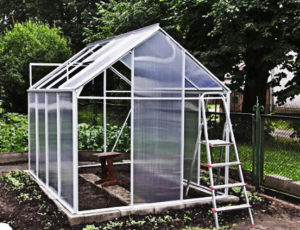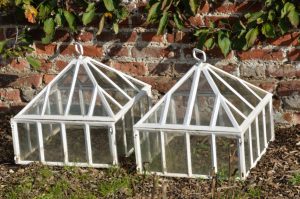
Gardening in the zone of risky farming, which includes most of the territories occupied by our dachas, is often very difficult and inefficient without a greenhouse. Before the widespread use of polycarbonate, there were few options for the device of indoor premises, most of them were of the ridge type. Now you can often see neat greenhouses with rounded roofs. Not every summer resident can confidently identify the pros and cons of various types of greenhouses.
Greenhouses usually come in two types — arched and with a roof in the form of a ridge. Let’s look at their device and analyze the pros and cons of each of the options.
Arched greenhouses
An arched greenhouse usually has a width of 2, 2.5 or 3 m and a length from 1.9 m to any arbitrary length that is a multiple of 1.9 m. As practice shows, the optimal dimensions of the greenhouse are as follows: the length is about 6 m, the width is 3 m.

The arched greenhouse has 2 wide doors, and above them-2 transoms located at the ends. As soon as the night temperature becomes positive, the transoms can not be closed at night. Both doors should be opened early in the warm season, until the temperature inside the greenhouse has risen to +10°With and above. So don’t oversleep this time. Even if the temperature outside is only +8…+10°C, then it can be about +20°C inside the greenhouse. If you open the doors at this time, the temperature inside will begin to equalize.
In other words, in the morning, with the appearance of the sun, the temperature in the greenhouse rises rapidly, and when you open the door, the temperature begins to decrease rapidly and only then slowly begins to rise again as the outside air warms up. What happens to the plants in this case? They freeze in anticipation of a stable temperature regime. The fact is that the chlorophyll in the green leaf reacts not so much to the temperature as to its gradient, that is, to the rate of its change. If there is a rapid change in temperature, then chlorophyll suspends its activity for 1.5-2 hours.

Thus, opening the greenhouses in the late morning, when you finally wait for the air temperature +12…+15°C, you actually force the plants to stop growing in the most useful morning hours: first — at a time when the temperature inside is rapidly rising, and then-when it drops sharply after opening the door. The greenhouse should be opened early, while the outside air temperature differs from the inside by no more than 2-3 degrees.
The latest models of arched greenhouses have different arcs in height, as shown in the figure below. Transoms located along the entire length usually open automatically as soon as the temperature inside rises above the set limit.

In such greenhouses, there is good ventilation, there is no too high temperature at which plant pollen is sterilized (and fertilization does not occur). In an arched greenhouse, it is most convenient to have 3 beds.

Skate greenhouses
Ridge greenhouses usually have a width of 2 m and an arbitrary length. Vertical racks along the length of the walls are usually placed after 50-60 cm when glazing and somewhat less often (70-80 cm) – when using a film or polycarbonate. Inside, 2 beds are arranged, located along the walls.

Pros and cons
I must say that arched greenhouses give better illumination to the plants planted in them. However, snow does not come off them well — gardeners constantly have to dump it themselves, because such structures do not hold the snow load well and simply fold under it. But the condensation formed on the ceiling does not fall down in the form of a drop on the top of the plants (which do not like it very much), but rolls down the walls.

From the roofs of the ridge greenhouse, the snow easily slides off by itself, so it does not require cleaning. But the vertical walls give poor lighting, the main flow of light goes through the roof — and therefore the lighting inside is much worse than in the arched one. Gardeners immediately noticed the difference as soon as arched greenhouses appeared: everything grows much better in them.
Materials for permanent shelter
Glass was usually used for permanent shelter, which is only suitable for ridge-type structures. Glazed greenhouses have a disadvantage — the glass weakly transmits the ultraviolet spectrum of light.
Polycarbonate, which is also used for permanent shelter, passes the entire spectrum of sunlight. It is much lighter and cheaper than glass and at the same time just as durable. In addition, polycarbonate, having a cellular structure, holds heat much better than glass.

However, glazed greenhouses have their own advantage — the glass is easy to wash in the spring, which improves lighting. And polycarbonate has some drawback in this regard. Since it is almost two-layered, in the autumn, small earthworms, slugs and other small things of the animal world easily penetrate into it as a wintering place. In addition, bacteria and plant microorganisms settle inside, polycarbonate turns green over time, and therefore the transparency of the material decreases over the years.
Films for temporary shelter
For temporary shelter of greenhouses, different types of film are usually used. And here arched structures have an advantage, since it is much easier to cover such a greenhouse and remove the shelter from it than to do all this with a ridge.

What kind of material should be used for temporary shelter? There are a lot of films on sale — each manufacturer praises his own.

Of course, the productivity of the greenhouse is affected not only by its design.




Leave a Reply